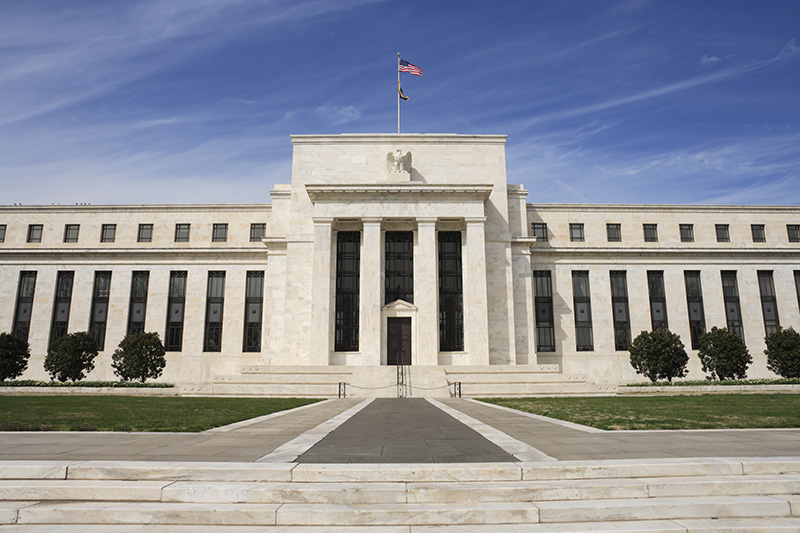 Fed Is Caught Between Phillips Curve and Yield Curve
Fed Is Caught Between Phillips Curve and Yield Curve(Bloomberg Opinion) — As the Federal Reserve prepares for its annual late August summit in Jackson Hole, Wyoming, financial markets will start to focus more on what monetary policy in 2019 is going to look like. What’s becoming clear is that there are now two main ways for how to think about monetary policy.
There’s the Phillips curve model, the theory that as the labor market continues to tighten it will put upward pressure on inflation and lead the Fed to favor continued interest rate increases. And there’s the yield curve model, the growing view that an inverted yield curve, with short-term interest rates having a higher yield than longer-term interest rates, would be bad for the economy and should be avoided. The yield curve model would argue for caution on interest rate increases, ending them perhaps as soon as the end of this year.
While members of the Federal Reserve have made comments regarding the yield curve in recent months, they’re currently adhering more to a Phillips Curve framework. In the Summary of Economic Projections they released at their June meeting, their plan was one or two more interest rate increases in 2018, three in 2019, and one additional one in 2020. With the target range for the Fed Funds rate currently between 1.75 and 2 percent, and with the 10-year Treasury rate at 2.84 percent, this would likely lead to an inverted yield curve sometime between the end of this year and the middle of next year, barring an increase in the 10-year Treasury rate.
Not everyone on the Fed is on board with this plan. Earlier this week, Atlanta Fed President Raphael Bostic pledged not to vote for an interest rate increase if it would invert the yield curve. Bostic is a voting member for the remainder of 2018, and it’s possible that this could come in play as soon as the December meeting. While Bostic won’t be voting in 2019 or 2020 when the yield curve seems likely to be inverted, the question is how many of his colleagues share his view. My Bloomberg Opinion colleague Tim Duy believes that for now, the Fed is more likely to ignore the signal from the yield curve inverting. I’m less sure.
There are three potential factions that could combine to put the Fed’s tightening cycle on hold. There’s the Bostic view of opposing an inverted yield curve because of the cautionary signal it implies for markets and the economy. There’s the potential that members of the Fed could be swayed by the president, who has now repeatedly complained about the Fed’s interest rate increases. And there’s Lael Brainard, who warned earlier in the year that the Fed’s tightening cycle could put pressure on emerging market economies – which it has – and that “the risk of a broader pullback bears watching.”
The Fed shifting from a Phillips curve framework to a yield curve framework could be a game-changer for the dollar. For the past several months the dollar has had a strong rally for a variety of reasons: continued interest rate increases from the Fed, the strong U.S. economy, and problems in emerging market countries and Europe.
A Fed that found a way to pause on interest rate increases in 2019 would change that for a couple reasons. First, the labor market has continued to tighten in 2018 on a variety of measures, including the overall unemployment rate, the broader under-employment rate, and the prime-age (25-54) employment-population ratio. Wage growth and inflation have ticked somewhat higher. Assuming the labor market continued to tighten but interest rate increases stopped, we could see higher inflation, flattish nominal interest rates, and therefore lower real interest rates on U.S. Treasuries, which is bearish for the dollar. Additionally, foreign central banks seem likely to be somewhat more hawkish in 2019 than they have been in 2018, and a shift from Fed tightening to foreign central bank tightening should put downward pressure on the dollar as well.
While it may be unlikely for now, this shift by the Fed is something to watch, and might represent the biggest potential catalyst for markets heading into the November elections.
Fusion Media or anyone involved with Fusion Media will not accept any liability for loss or damage as a result of reliance on the information including data, quotes, charts and buy/sell signals contained within this website. Please be fully informed regarding the risks and costs associated with trading the financial markets, it is one of the riskiest investment forms possible.
Source: Investing.com


























